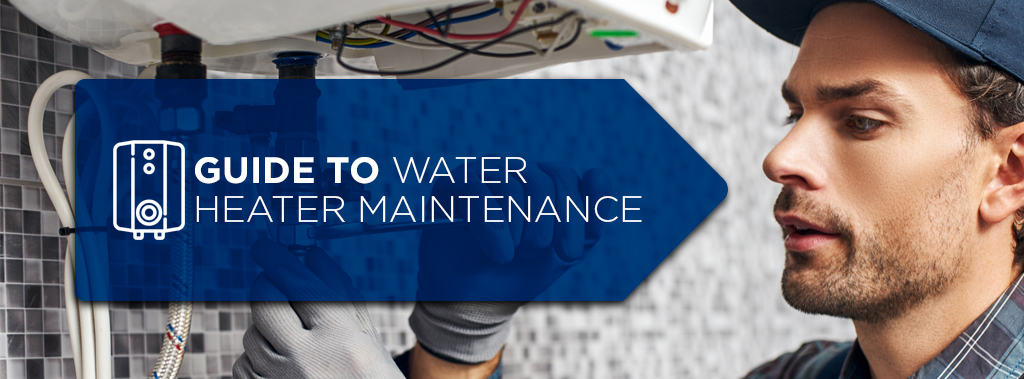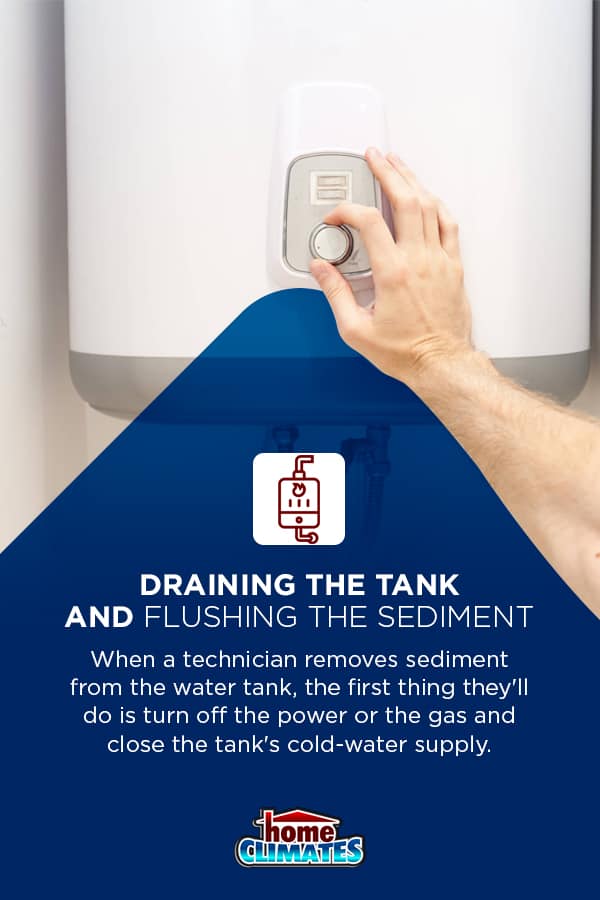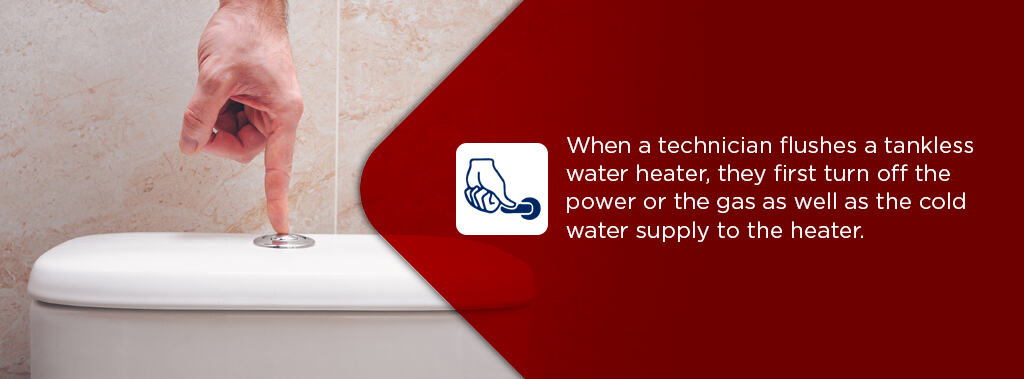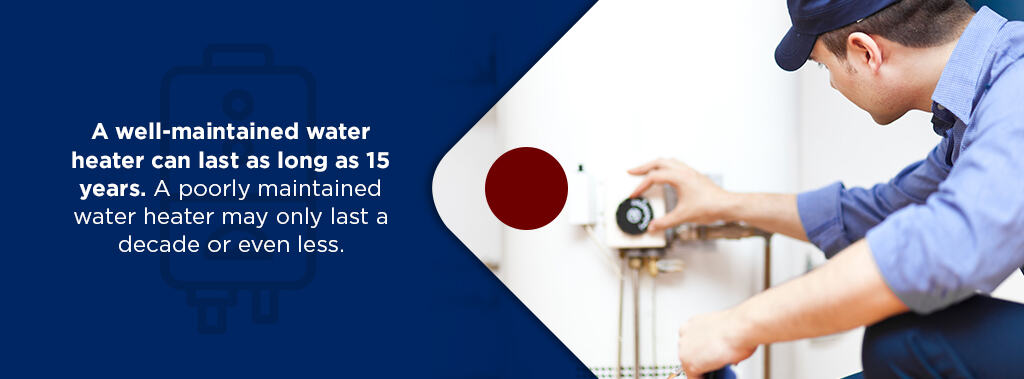Readily available hot water is one of the great gifts of modern life. After a long day on the job, is there anything more welcome than a hot shower? The water seems to carry away stress, and many people stand in the shower for minutes while the hot water flows over them.
There are a few things so frustrating or disappointing as waiting all day to have that hot shower, turning on the faucet, getting into the shower and having the hot water run out after only a few minutes. Unless you’re in the proper mood or it’s a 95° day, cold showers are not something most people relish.
How can this happen? No one else in the house has had a hot shower all day. Why does your hot water run out so quickly?
The problem may be that your hot water heater needs maintenance. Just like your car or your air conditioning system, your water heater requires regular upkeep. Some aspects of water heater maintenance need to be performed yearly while others can be done every three to five years. It depends on the kind of water heater you have — electric, gas or tankless.
You should schedule a regular maintenance checkup for your hot water heater with a reliable company. Spending a little money now to make sure your water heater runs properly will save you money in the future. Poorly maintained water heaters expire much faster than water heaters that receive regular maintenance. Here are some things you should track while maintaining a water heater.
Central PA Water Heater Services
Electric and Gas Water Heater Maintenance Checklist
When you hire experienced technicians to do regular maintenance on your electric or gas water heater, make sure they check the following things.
1. Testing the Pressure Relief Valve of Water Heaters
The pressure relief valve is located on the top or side of your water heater. Its main job is to open and let out water if too much pressure builds up inside the tank. Water heater tanks can explode if there’s too much pressure.
The technician performing maintenance will first turn off the power and shut the valve that supplies cold water to the tank. The technician will then place a bucket under the pressure release valve. They will test the valve by lifting its tab to see if any water comes out.
If it does, your tank is in good shape. If no water comes out, you need to replace the valve. You will also need to replace the valve if the technician lifts the tab and water flows out and then continues to come out after the technician releases the tab. In both cases, the valve is too old or broken to work properly.
If water continues to flow, the technician will drain more of the tank, then use a pipe wrench to unscrew the old valve and replace it with a new one.
2. Checking the Anode Rod
Our society values clean water. Yet even what we think of as the cleanest water has minerals and impurities in it. This is especially the case if you live in areas where you are more likely to have “hard water.” When you describe water as hard, it means the water contains more minerals. Hard water is not bad for you but can be very bad for your hot water heater.
If you leave this water untreated, it will quickly corrode your water heater. Every water heater needs something to prevent this from happening. This is the purpose of the anode rod in an electric or a gas water heater. It draws in corrosive materials so that the anode corrodes instead of the water heater.
How can the technician tell if it’s time to replace an anode rod? First, they turn off the gas or power, then the shut-off valve. They open a hot water tap anywhere in the house, which releases the system pressure inside the tank. Then they open the drain valve and drain some water from the tank. If the water contains flakes of rust, this means you waited too long and it is time for a new water heater.
If the water looks clear, the technician will next check the water heater anode rod. There are some telltale signs that it needs to be replaced:
- Calcium coats the anode rod.
- An anode rod has a core steel wire. If more than 6 inches of this wire have been exposed, it’s time for a new rod.
- The thickness of the anode rod makes a huge difference. If there is less than half an inch of the rod left, it needs to be replaced.
Fortunately, replacing an anode rod is not expensive. You should replace the anode rod every three to five years because this will significantly extend the life of a water heater.
3. Draining the Tank and Flushing the Sediment
Even though the anode rod attracts corrosive materials, that doesn’t mean it’s picking up everything that comes in with the water. Each time your hot water heater refills itself, the water supply includes some particles of sediment.
This sediment is hard to notice if your tank only fills once. Water heaters, however, fill countless times over a year. This means that sediment continues to gather at the bottom of the tank. Sediment in a tank is one of the main reasons hot water does not stay hot as long as people would like.
When a technician removes sediment from the water tank, the first thing they’ll do is turn off the power or the gas and close the tank’s cold-water supply. They will turn on a hot water tap somewhere in the house. The technician will then attach a garden hose to the drain valve, normally located at the bottom of the tank, open it and drain off a few gallons at a time.
If the water that comes out is cloudy, the technician will reopen the cold-water supply in order to churn the remaining sediment. They will continue to do this until clear water comes out of the garden hose. The drain valve is closed. The tank refills and the power is turned back on. This is a maintenance item that needs to be done yearly if not every six months or so.
4. Adjusting the Water Temperature
As the technician does the maintenance, ask them to turn the tank to 120 degrees. This temperature setting will still provide hot, comfortable showers but for every 10 degrees you lower the temperature, you can save as much as 5% on your energy bill.
You might want to ask the technician to show you how to do this so you can do it yourself in the future. If you know you’re going to be away from home for three days or longer, you should set the water heater thermostat to its lowest setting or just turn it off. If not, you are paying to heat the water without anyone there to enjoy it.
5. Insulating the Pipes
By insulating your hot and cold water pipes, you help reduce heat loss and also prevent condensation in summer months. The technician will use 3/8-inch thick sticking foam pipe insulation. This will match the diameter of the pipes. They will then slide this insulation over the pipes as far as possible. The technician will peel the tape and secure the insulation. If the pipe is very close to the flue, the technician may use unfazed fiberglass pipe wrap for insulation.
6. Insulating the Water Heater
Many people ask us, do I need to insulate my water heater? Insulating it can help keep hot water hot when it’s surrounded by cold air.
To insulate a hot water heater, first check to see how old it is. Newer water heaters already contain insulation. If your water heater is at least five to 10 years old, it might need insulation. Check to make sure using insulation won’t void the warranty. The technician will use an insulating material like R-4.5 foil-covered bubble wrap. They fit this wrap around the tank, leaving holes for pipes, panels and the pressure relief valve, if it is on the side of the tank.
The material will then be sealed. If the tank is an electric water heater, the technician might cover the top with a large piece of insulation and tape it to the side of the tank. The tops of oil and gas water heaters are never covered.
By insulating the pipes and the water heater, you will improve your tank’s hot water efficiency, and you’ll be able to enjoy those longer showers you desire.
There is one other thing you can do to make your water heater more efficient. Keep the area around your water heater tank uncluttered. Clear about 2 feet of space around the tank unless the user manual states something different.
Central PA Water Heater Services
Tankless Water Heater Maintenance
We’ve also pulled together tips on how to maintain tankless water heaters. Unlike electric or gas/oil water heaters, tankless water heaters provide hot water on demand. Hot water is not stored in a tank, so many of the items mentioned above don’t apply to tankless water heaters. They still, however, require regular maintenance — yearly in most cases, but if you have hard water, it needs to be done more often.
Flushing the Tankless Water Heater
When a technician flushes a tankless water heater, they first turn off the power or the gas as well as the cold water supply to the heater. Then they turn off the hot water valve that takes hot water from the unit to the various taps in your home. Next, they attach a hose to a re-circulation pump and then to the tankless water heater’s cold water isolation valve.
They then take a second hose and attach it to the hot water isolation valve. The pump and the hose attached to the hot water isolation valve are placed into a bucket that holds about 5 gallons. The technician fills the bucket with 5 gallons of fresh white vinegar, the same kind you would use for cooking or a similar food-grade cleaner.
The technician opens both isolation valves and turns on the pump. The food-grade cleaning solution circulates through the tankless water heater for about 10-20 minutes. When finished, the technician disposes of the food-grade cleaning solution, fills the bucket with water and repeats the operation for about five minutes.
After five minutes, the technician will return all valves to their normal settings. This rids the tankless water heater of impurities such as scale that naturally builds up in your tankless water heater. This scale can cause your water to not be as hot and make it more expensive to heat, thus making flushing very important.
Central PA Tankless Water Heater Services
Preventive Maintenance for Water Heaters
Your water heater is probably not something you think a lot about unless it doesn’t work. If you want to keep it working properly, you should schedule regular maintenance. A well-maintained water heater can last as long as 15 years. A poorly maintained water heater may only last a decade or even less.
Regular water heater maintenance may seem like yet another chore to schedule but when compared to the cost of replacing a faulty water heater before its time, as well as living several days or longer without hot water, it is very much worth the effort.
Schedule Water Heater Tune-Up Service With the Experts at Home Climates
Whether you want to arrange a regular maintenance schedule for your gas, electric or tankless water heater or if you want to install a new one, call the home comfort experts at Home Climates.
We offer over-the-top service at a fair price. Call us 24/7 to schedule a service. We can send you reminder calls so you can schedule your regular maintenance and then do follow-up calls to ensure everything works properly.
We have flat-rate, upfront pricing, and we service all brands of equipment. When you need fast and reliable service at a fair price, Home Climates is the company you should call.
If you would like to talk to one of our expert representatives about your water heater, plumbing, heating and cooling, geothermal or water treatment needs, call us at 717-689-4151 or visit our contact us page where you can let us know the service you’re interested in and the best time of day to contact you. A member of our team will get back to you within one business day or sooner.















